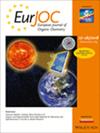重原子增强咔唑取代的BODIPY染料的光氧化性能
IF 2.7
3区 化学
Q2 CHEMISTRY, ORGANIC
引用次数: 0
摘要
本研究合成了中间位含咔唑基团的卤化BODIPYs (C‐Br2‐BDPY和C‐I2‐BDPY),并利用各种光谱技术对其进行了表征。单晶X射线衍射分析表明,C - I2 - BDPY为三斜晶系,具有P - 1空间群。对BODIPY衍生物的光学性质、单线态氧生成能力和光催化活性进行了评价。而非卤化BODIPY (C‐BDPY)的单线态氧生成可以忽略不计(ΦΔ < 0.05),碘化(C‐I2‐BDPY)和溴化(C‐Br2‐BDPY)衍生物的单线态氧量子产率分别为0.82和0.73。在1,5‐二羟基萘(DHN)与核桃酮的光氧化反应中,这些卤化BODIPY化合物在1小时内对C‐Br2‐BDPY的转化率为62.6%,对C‐I2‐BDPY的转化率为87.8%。BODIPY光敏剂的周转率值随着时间的推移呈连续增加的趋势,表明产物形成持续,而周转率值则逐渐下降,反映了随着工艺的进行反应速率的降低。密度泛函理论计算支持实验结果,证明了重原子的存在促进了系统间的交叉,增强了光氧化反应的热力学可行性。本文章由计算机程序翻译,如有差异,请以英文原文为准。
Heavy Atom‐Enhanced Photooxidation Performance of Carbazole‐Substituted BODIPY Dyes
In this study, halogenated BODIPYs (C‐Br2 ‐BDPY and C‐I2 ‐BDPY) bearing a carbazole group at the meso position are synthesized and characterized using various spectroscopic techniques. Single‐crystal X‐ray diffraction analysis of the C‐I2 ‐BDPY revealed that it crystallizes in a triclinic crystal system with a P ‐1 space group. The optical properties, singlet oxygen generation capacities, and photocatalytic activities of the BODIPY derivatives are evaluated with respect to juglone synthesis. While the nonhalogenated BODIPY (C‐BDPY) exhibit negligible singlet oxygen generation (Φ Δ < 0.05), the iodinated (C‐I2 ‐BDPY) and brominated (C‐Br2 ‐BDPY) derivatives demonstrate considerably higher singlet oxygen quantum yields of 0.82 and 0.73, respectively. In the photooxidation reaction of 1,5‐dihydroxynaphthalene (DHN) to juglone, these halogenated BODIPY compounds achieve conversion yields of 62.6% for C‐Br2 ‐BDPY and 87.8% for C‐I2 ‐BDPY within one hour. The turnover number values of the BODIPY photosensitizers show a continuous increase over time, indicating sustained product formation, whereas the turnover frequency values gradually decline, reflecting the decrease in reaction rate as the process progress. Density functional theory calculations support the experimental results by demonstrating that the presence of heavy atoms facilitates intersystem crossing and enhances the thermodynamic feasibility of the photooxidation reactions.
求助全文
通过发布文献求助,成功后即可免费获取论文全文。
去求助
来源期刊
CiteScore
5.40
自引率
3.60%
发文量
752
审稿时长
1 months
期刊介绍:
The European Journal of Organic Chemistry (2019 ISI Impact Factor 2.889) publishes Full Papers, Communications, and Minireviews from the entire spectrum of synthetic organic, bioorganic and physical-organic chemistry. It is published on behalf of Chemistry Europe, an association of 16 European chemical societies.
The following journals have been merged to form two leading journals, the European Journal of Organic Chemistry and the European Journal of Inorganic Chemistry:
Liebigs Annalen
Bulletin des Sociétés Chimiques Belges
Bulletin de la Société Chimique de France
Gazzetta Chimica Italiana
Recueil des Travaux Chimiques des Pays-Bas
Anales de Química
Chimika Chronika
Revista Portuguesa de Química
ACH—Models in Chemistry
Polish Journal of Chemistry.

 求助内容:
求助内容: 应助结果提醒方式:
应助结果提醒方式:


